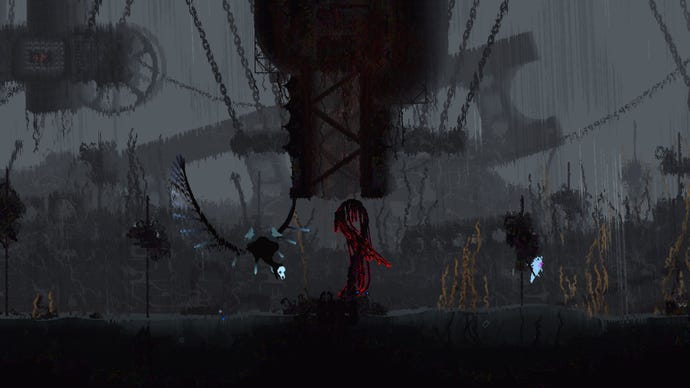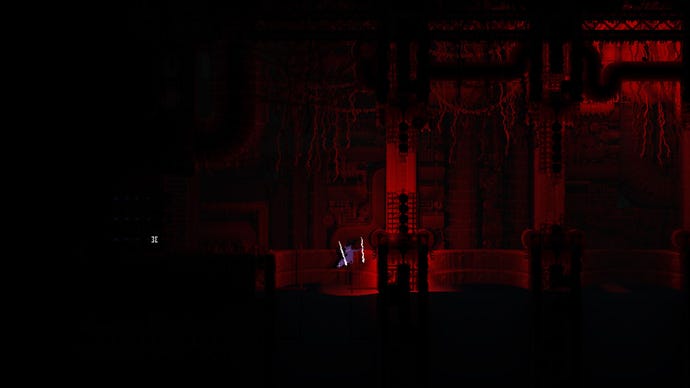Rain World's Downpour DLC cements it as a fascinating and underrated beast
It'll take dozens of hours to only partially understand it
An adorable family of furry mammals traversing a dystopian urban environment; snapshots of joy and intimacy (playful hunts, mutual grooming, snuggling together for a nap) already infused with the melancholy of impending catastrophe; the terrible, life-altering moment when a young cub loses its footing and plunges into unknown depths, separated from the pack. Our fledgling protagonist, alone for the first time, has to fend for itself and find its way among the perilous mega-city ruins.
If you engaged at all with the indie-game sphere in 2022, chances are this introduction rings a bell. Only it’s not a description of last year’s breakaway hit and multi-award winner, BlueTwelve Studio’s Stray, but an older and much more brutal feline saga, Videocult’s grim survival action game Rain World. The thematic overlap of these games, coupled with their contrasting design philosophies, provides an excellent springboard to reassess the latter – one of the most opaque, challenging, and underappreciated titles in recent memory, just in time for the arrival of its first official DLC, Rain World: Downpour.
Here’s the crucial difference: Stray makes you feel for its disoriented, frail protagonist, whereas Downpour makes you feel like one of them. In a long-form essay for Emergence Magazine, eco-philosopher David Abram tries to convey the “radical otherness” of a non-human consciousness (such as a spider’s or a whale’s); “the styles of sensibility and intelligence that thoroughly exceed the limits of our own sentience”. But, through unambiguous sign-posting, conventional level-design, and a robotic companion who gently steers you in the right direction, Stray bridges that inter-species gap and presents an imminently intelligible challenge. It communicates in a superficially alien language but prompts you with the controller's familiar buttons and triggers, making sure you’re never truly at a loss in its neon-drenched alleys and rubble-strewn rooftops. Your lost kitten reads BlueTwelve’s city like a veteran backpacker.
On the opposite end of the spectrum, Downpour’s desperate trek immerses you in the plight of its loveable slugcats through uncompromising obscurity and relentless hostility – an unflinching resolve to simulate bewilderment, the world seen through a lost pup’s beady, fretful eyes. As with the original Rain World, vital information is withheld: for example, the powers that differentiate the new characters – whose five campaigns form the centerpiece of this DLC – are given a quick once-over, but you’re left to discover their nuance (the kind of items the Gourmand can concoct; how the Artificer’s explosive spears interact with the environment) through trial and deadly error. Nothing works smoothly or intuitively, not even your character’s procedurally generated movement, which often results in the otherwise elegant creatures landing on their backside with a thump. And blatant unfairness, such as exiting one of Downpour's winding tunnels straight into the mouth of a starving reptile, is the order of the day.

Such are the vagaries of existence in a living, breathing, immensely complex ecosystem. And, just like your fuzzy avatar, your only choice is to struggle to comprehend Downpour by paying attention to your surroundings with all the single-minded focus of an animal whose life depends on it: pricking up your ears to catch the flapping of a vulture’s massive wings off-screen, or freezing the moment something slithers in the underbrush nearby. Most of all, you must learn to anticipate the approaching storm and making a dash for the closest shelter the moment you hear its rising roar so you can survive the cataclysm and emerge in its aftermath to the soft patter of rain, beginning the cycle once again.
Coming to grips with the inner workings of this world can be exhausting, but the sheer impenetrability perfectly captures the helplessness of an animal trapped in an environmental catastrophe engineered by humans, which explains how Downpour remains so utterly absorbing. The word “frustration” appears no less than six times in RPS's review of the base game, yet, his mixed verdict notwithstanding, Brendan Caldwell confesses a deep fascination with it.
It perfectly captures the helplessness of an animal trapped in an environmental catastrophe
Even for someone like me, who’s much less ambivalent about their admiration, Rain World can be a draining experience. Every time I managed to reach a new shelter and successfully hibernate it triggered a mixture of elation and relief akin to discovering a bonfire in a Souls game, and I would instinctively quit, fearing something might happen at the last moment to take that hard-fought victory away. I would reload within a couple of minutes, after I'd caught my breath, knowing full well the barrage of death I’d have to endure the moment I stepped out. Occasionally even prior to that, such as the time when a Komodo-like predator snuck inside the room and slept with me, waking up the moment I tried to move its massive bulk from the exit and devouring me in an instant.
Two things mitigate Downpour's overwhelming opacity. First, the fact that in the five years since the original game’s release some of its more inscrutable features have been thoroughly documented, analysed, and disseminated. So, if you’ve heard of Rain World, chances are you may be vaguely aware of how its patterns of foraging, exploration, and hibernation work, or that the mysterious seals blocking your progress can be removed by successfully completing those cycles in order to accumulate karma. Even if you’re not, there’s a ton of resources out there explaining everything, from the behaviour of its fearsome predators to the hidden lore of its desolate cities, in minute detail.


Second, while not exactly giving its secrets away, Downpour at least lets you approach them from different angles with a wealth of new modes. For example, Challenge offers an array of mini-scenarios that allow you to hone specific skillsets, while in Safari you momentarily step into the shoes of different species to observe how they interact, with no fear of ruining your progress. Among its five new characters you’re bound to find one tailored to your individual playstyle, whether that’s the ultra-aggressive Spearmaster, the amphibian Rivulet, or the Saint, whose long, sticky tongue lets you swing from rusty drainpipes and out-of-reach ledges like a furry Tarzan. And if all else fails, the newly implemented Jolly Co-op option should somewhat alleviate the despair of successive failure.
Crucially, Downpour achieves all that without sacrificing its core principles of opacity and all-pervading hostility. New biomes brim with unidentified threats, each new slugcat’s abilities will take dozens of hours to fully parse, and even fundamental mechanics are subverted to keep players guessing, most notably in a campaign that completely eschews storms (and is, naturally, not at all easier for it). This is a world that remains as intimidating and enigmatic as ever.
Several decades prior to Abram’s piece on inter-species radical otherness, one of the 20th century’s most celebrated (and, fittingly, most opaque) philosophers, Ludwig Wittgenstein, addressed similar notions by famously declaring that “if a lion could speak, we could not understand him”. With the release of Downpour, Rain World re-emerges as one of gaming’s most fearsome and unpredictable beasts, one whose language we can never hope to fully decipher – and is all the more fascinating for it.


